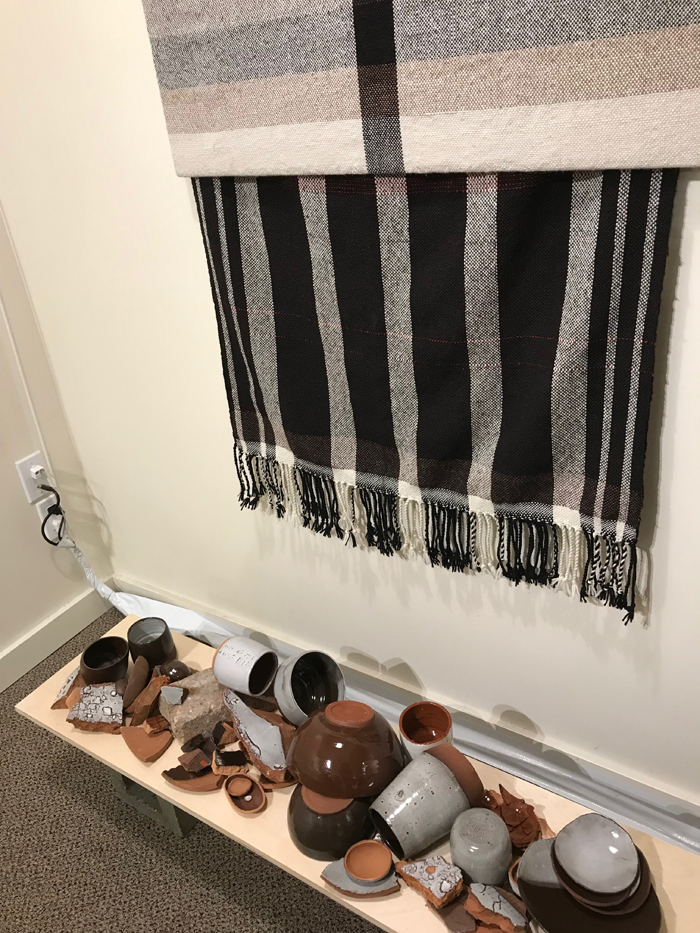Artist, educator and recent Salt Spring Ceramics Awards juror Alwyn O’Brien is guest curator at Fault Line Projects gallery this month, bringing a show that uses clay as the jumping-off point for innovative artist collaborations.
O’Brien was born and raised on Salt Spring and now lives part-time on the island, when teaching duties at Langara College aren’t keeping her in Vancouver. An award-winning ceramic artist, she completed her MFA at the University of Washington in Seattle in 2010. Her work is held by museums in Canada and the United States.
A fresh, youthful approach characterizes O’Brien’s curating style. She explains in her statement she wanted to create a show where new kinds of conversations would be developed and discoveries could be made, both by the viewers and the artists. The result was four artist pairings and one trio cooperating on new work, “with clay the material that binds the collaborators.”
O’Brien’s own contribution with Catherine Fairbanks consist of three wall-mounted ceramic platters that are exuberant in their decor. Glaze is applied in the manner of thickly textured oil paint in expressionist paintings. The titles Satyr, Swan and Harpy give the sense of mythology behind the emotion; or perhaps the ancient roots underpinning modern creative acts.
Sarah Coote and Kent Anderson collaborate on a unique series of “salt pigs” — open ceramic pots for storing kitchen salt. Though used to collaborating on daily family life in their 35 years together, this is the first time the pair has worked directly together on their art. They found that required a negotiation between two different styles and feelings that created something new and exciting for both.
“If you’re in your own head, that’s where you tend to stay, and this gets you out of your own head,” Anderson observed.
Coote’s salt pigs sit off-kilter and mainly comprise two interlocking components, like a curved section of piping set into another piece. Anderson, a sculptor, has created graceful metal frames for each piece. Industrial designs influenced the shapes of both components, with iItems such as a ship-board venting pipe and the framed construction site concrete bucket stepping-off points for form and line.
The pots themselves are mainly made of red clay, which contrasts nicely with glaze in thick cream, glossy black or smooth jade green. (The interiors are left unglazed to draw moisture from the salt.) They are satisfyingly sized so that a chef could grab an entire handful of salt at once.
Zoe Kreye’s clay vessel/sculpture sits atop a low pedestal of industrial foam. The piece becomes the totem in a series of dramatic photos by Luciana d’Anunciacao featuring a female figure. The background installation, also by Kreye, features a jumble of grey and white painted concrete, seen in extremely shallow depth of field. The model’s bare skin provides the only colour amid the strange built environment, where a theatrical or dance-informed investigation of movement is key.
Doing Washing combines three elements: a lithograph print of a concrete riverbank laundry operation in the Philippines, mounted on a wide sheet of yellow manila paper (Christian Vistan); very small stoneware laundry cut-outs finished with “sink glaze” laid out on a low shelf (Jasmine Baetz); and a wet-looking lump of clay on a rock (Anna Gustafson). The components combine for a multi-model exploration of the elements: earth and water most obviously but also air and heat. The materials used themselves enter the feedback loop of modern and traditional, from the paper originally named for the Philippines hemp fibre to the glazed tiles that speak of the laundry sink, and the clay that is somehow agent of both dirty and clean.
Mima Preston and Cathy Terepocki “locate their practice in the immediacy of place and identity.” Terepocki’s River Clay Pile is a jumble of intact and broken vessels made from clay dug from the Chilliwack River. The collection’s placement resembles the river stones left exposed on the banks by receding waters, with chocolate and cream glazing emphasizing the deep earthy connection to the ground. Preston’s woven piece is made from wool sourced from Salt Spring alpaca and also utilizes natural/earth tones. A panel of horizontal bars at the top overlaps one of the vertical stripes below, providing an architectural formalism to the supple fibres.
The show continues at Fault Line Projects through Jan. 5.

